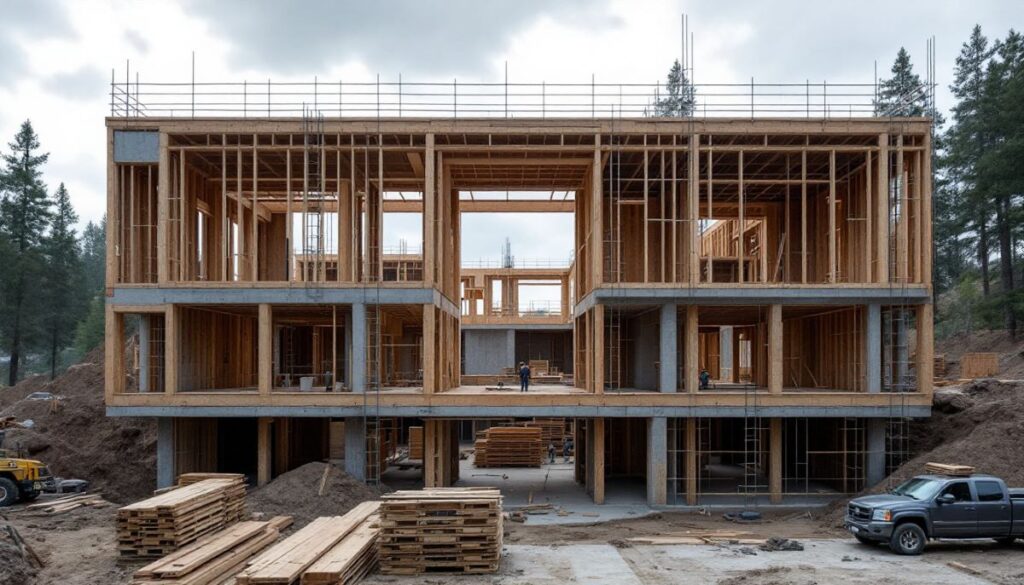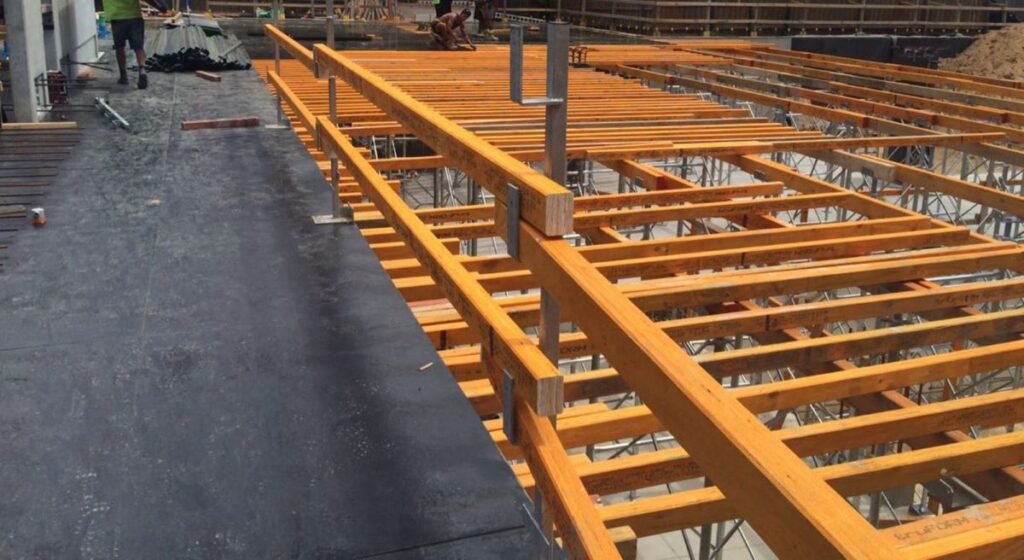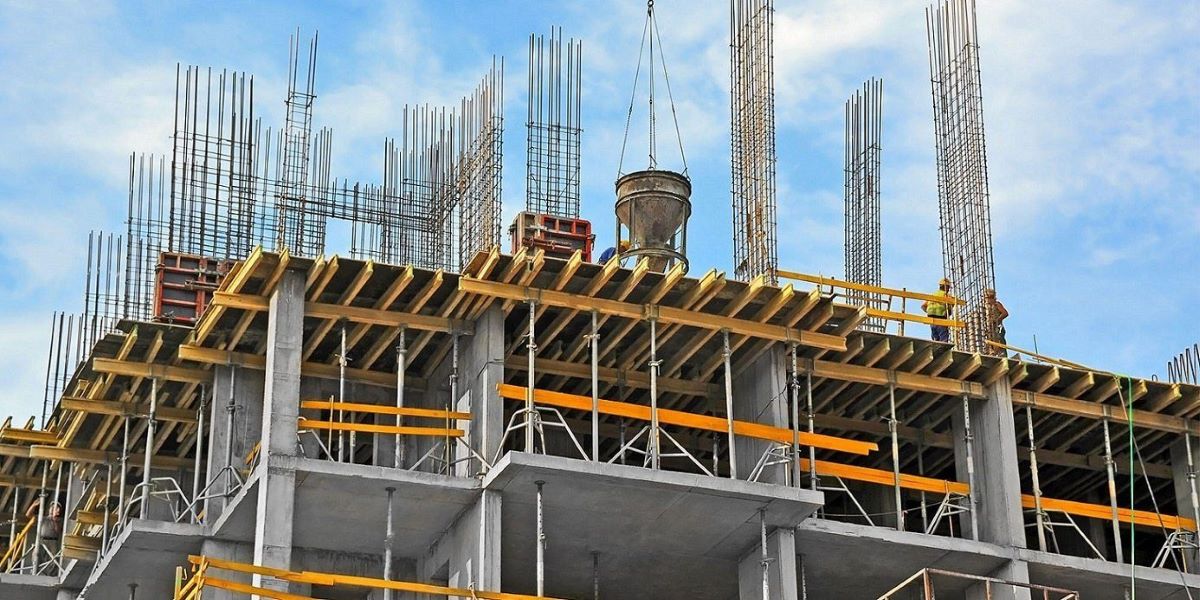What Is Formwork LVL and How Is It Manufactured?
Formwork LVL is an innovative engineered timber product specifically designed for construction projects. It is a type of Laminated Veneer Lumber that combines multiple thin layers of wood veneers using advanced bonding techniques, resulting in a structural material that is stronger and more consistent than traditional timber.
The Manufacturing Process
The manufacturing process of Formwork LVL involves several key steps:
- Veneer Selection: Carefully chosen plantation timber veneers are selected for production.
- Moisture Content Standardisation: The moisture content of the veneers is standardised to ensure optimal bonding during lamination.
- Adhesive Application: Waterproof phenolic resins are used to apply structural adhesives between each veneer layer.
- Hot-Press Lamination: The veneers are then subjected to controlled temperature and pressure in a hot press to bond them together.
- Precision Cutting: After lamination, the laminated panels are cut to precise dimensions according to specifications.
Quality Control Measures
To maintain high quality standards, rigorous quality control measures are implemented throughout the manufacturing process. This includes testing for modulus of elasticity, bending strength, and dimensional stability to ensure compliance with Australian construction standards.
Benefits of Formwork LVL
The meticulous manufacturing process of Formwork LVL results in beams that possess several advantages:
- Strength: The combination of multiple veneer layers and parallel grain direction maximises load-bearing capacity, making Formwork LVL suitable for heavy-duty applications.
- Consistency: Unlike natural timber which can vary in strength and appearance, Formwork LVL offers uniformity in performance and aesthetics.
- Dimensional Stability: The engineered nature of Formwork LVL minimises the risk of warping or twisting over time, ensuring reliable performance throughout its lifespan.
These qualities make Formwork LVL an essential component in modern building techniques, particularly for formwork systems used during concrete pouring operations where substantial loads are encountered.
Why Is Formwork LVL Considered Strong and Reliable for Construction Projects?
Formwork LVL strength comes from its exceptional engineering properties that are better than traditional timber products. The high modulus of elasticity in LVL formwork reaches about 13,800 MPa, providing superior resistance to bending and deflection under heavy concrete loads. This increased stiffness directly leads to improved load-bearing capacity, enabling you to span larger distances with fewer support points.
Superior Strength and Load-Bearing Capacity
The lamination process creates uniform dimensions throughout each beam, eliminating the natural inconsistencies found in solid timber. You can rely on consistent performance across every piece, with dimensional tolerances maintained within ±1mm. This precision manufacturing ensures structural integrity remains constant, whether you’re working on residential slabs or multi-storey commercial projects.
- Engineered Composition: LVL’s engineered composition distributes stress evenly across the entire cross-section, preventing localised failure points that commonly occur in natural timber.
- Controlled Moisture Content: The controlled moisture content of 8-12% reduces shrinkage and warping, maintaining structural stability throughout the concrete curing process.
- Reliable Performance: This reliability allows you to achieve consistent concrete finishes whilst minimising the risk of formwork failure during critical pours.
How Does Formwork LVL Improve Efficiency and Cost-effectiveness on Site?
Formwork LVL efficiency transforms construction timelines through precision manufacturing that eliminates common site delays. You receive beams cut to exact specifications, reducing the need for on-site modifications that typically consume valuable labour hours. This precision manufacturing means your crew can install formwork systems faster, keeping projects on schedule.
The cost reduction benefits become apparent through multiple reuse cycles. Quality LVL formwork withstands repeated concrete pours without compromising structural integrity. You can expect:
- 15-20 reuse cycles from properly maintained LVL beams
- Reduced material waste compared to single-use alternatives
- Lower labour costs due to faster installation times
- Minimised equipment hire through extended product lifespan
Durability plays a crucial role in construction efficiency. The engineered nature of LVL means consistent performance across multiple projects. You won’t face unexpected failures that halt concrete pours or require emergency replacements. This reliability translates directly into predictable project costs and timelines.
The combination of precision dimensions and robust construction creates a formwork solution that pays for itself through reduced labour requirements and extended service life.
What Are the Common Applications of Formwork LVL in Construction?
Formwork LVL applications are used in various construction projects, with vertical formwork applications and horizontal formwork applications being the most common. This engineered timber performs exceptionally well as structural beams and bearers in commercial buildings, where its consistent strength properties provide reliable performance under heavy loads.
Applications of LVL in Commercial Construction
Commercial construction projects benefit significantly from LVL’s versatility. You can utilise it for:
- Primary structural beams supporting concrete slabs
- Load-bearing bearers in multi-storey developments
- Temporary support structures during construction phases
- Curved formwork applications for architectural concrete features
Advantages of LVL’s Size and Length Options
The availability of suitable sizes and lengths for different project needs makes LVL particularly attractive for construction teams. Standard lengths typically range from 2.4 metres to 6 metres, though you can order custom lengths up to 12 metres for specialised applications. This flexibility eliminates the need for multiple joints in longer spans, reducing installation time and potential weak points.
Applications of LVL in Residential Projects
Residential projects also leverage LVL’s capabilities, particularly in suspended slab construction and retaining wall formwork. The material’s dimensional stability ensures consistent concrete finishes, whether you’re working on high-rise developments or single-storey commercial structures.

How Does Formwork LVL Compare to Other Timber Products Like F14 and F17 Plywood?
When choosing timber products for construction formwork, it’s crucial to understand the differences between F14 plywood and F17 plywood to ensure the success of your project. These formwork plywood grades represent different strength classifications that directly affect the outcome of your construction work.
Understanding F14 and F17 Plywood
F14 plywood has a stress grade of 14 megapascals, making it suitable for lighter structural applications and residential projects. You’ll find that F14 performs well in situations where moderate load-bearing capacity is required while still being cost-effective for budget-conscious projects.
On the other hand, F17 plywood offers superior performance with a stress grade of 17 megapascals, providing greater strength and durability for demanding commercial applications. This higher grade can handle heavier loads and withstand prolonged exposure to the conditions typically found on construction sites.
Why Choose Formwork LVL?
While both F14 and F17 plywood have their advantages, Formwork LVL (Laminated Veneer Lumber) outperforms both grades due to its engineered construction process. The manufacturing method used for LVL involves layering thin veneers of wood together with adhesive, creating a strong and stable material.
This process offers several benefits over traditional plywood products:
- Higher modulus of elasticity: This means that LVL has a greater resistance to bending compared to both F14 and F17 grades.
- Uniform dimensional stability: The layered construction of LVL reduces the risk of warping or twisting, ensuring that it maintains its shape even under varying environmental conditions.
- Extended reuse cycles: LVL’s superior durability allows it to be reused multiple times without sacrificing performance.
- Precision manufacturing: Unlike plywood which may have natural variations in strength due to knots or other defects, LVL is manufactured with strict quality control measures in place. This results in consistent strength properties throughout the entire beam length, reducing the need for on-site adjustments during installation.
By choosing Formwork LVL for your construction projects, you can benefit from these advantages over traditional timber products like F14 and F17 plywood.
What Are the Best Practices for Installing Formwork LVL to Maximise Strength?
Proper LVL installation requires careful attention to positioning and support systems to achieve maximum structural performance. You need to understand the specific requirements for both vertical and horizontal applications to ensure your formwork delivers optimal results.
Vertical Applications
When installing LVL beams vertically, position them with the grain running parallel to the load direction. This orientation maximises the modulus of elasticity and ensures the laminated structure works as intended. You should:
- Secure vertical LVL beams at regular intervals using appropriate bracing
- Check alignment using spirit levels before concrete pouring begins
- Ensure adequate bearing surfaces at top and bottom connection points
Horizontal Applications
For horizontal installations, place LVL beams with the strongest face oriented to resist bending forces. The formwork best practices dictate that you maintain consistent spacing between supports to prevent deflection under concrete loads.
- Position supports at manufacturer-recommended centres
- Use temporary props during installation to maintain beam alignment
- Verify that connection hardware matches the LVL’s load capacity
Accurate installation techniques directly impact the reusability of your LVL formwork, making proper positioning essential for both immediate structural integrity and long-term cost effectiveness. Check out more about F14 vs F17 Grade Plywood: Choosing the Right Option for Formwork.
How Does Proper Reo Bar Installation Complement Formwork LVL Performance?
Reo bar installation is essential for achieving the strength of reinforced concrete when using Formwork LVL systems. The precision manufacturing of LVL timber creates stable, dimensionally accurate formwork that maintains consistent spacing for reinforcement bars throughout the concrete pour.
The correct positioning of reo bars within your LVL formwork structure directly affects the final concrete strength. You need to ensure adequate concrete cover around each bar while also maintaining proper spacing between parallel reinforcement. The uniform dimensions of LVL beams and bearers provide reliable reference points for positioning reo bars at specified distances from formwork faces.
Critical installation considerations include:
- Maintaining minimum concrete cover requirements (typically 20-40mm depending on exposure conditions)
- Securing reo bars with appropriate ties to prevent movement during concrete placement
- Ensuring proper lap lengths where bars join
- Positioning bars to avoid interference with formwork removal
The structural integrity of your LVL formwork system supports the weight of concrete and reinforcement without deflection, preventing reo bar displacement that could compromise reinforced concrete strength. This stability becomes especially important in vertical applications where concrete pressure increases with height.
What Maintenance Practices Ensure Longevity and Reusability of Formwork Plywood and LVL?
Formwork maintenance directly impacts your project’s bottom line through extended material lifespan and consistent performance. Proper care transforms single-use materials into reusable formwork materials that deliver value across multiple pours.
Immediate Post-Pour Cleaning
- Remove concrete residue whilst still wet using plastic scrapers
- Apply release agent remover to eliminate stubborn buildup
- Rinse thoroughly with clean water to prevent chemical damage
Storage Requirements
You must store formwork materials flat and elevated off ground level. Stack panels with timber bearers between each sheet to promote air circulation. Cover stored materials with waterproof sheeting whilst ensuring adequate ventilation to prevent moisture accumulation.
Surface Protection
Inspect panels after each use for damage, splinters, or delamination. Sand rough surfaces smooth and apply protective coatings where necessary. Replace damaged sections immediately to maintain structural integrity.
Handling Protocols
Train your crew in proper lifting techniques and use mechanical aids for larger panels. Edge damage from careless handling reduces reuse potential significantly. Mark damaged areas clearly to prevent inadvertent use in critical applications.
Additionally, understanding the nuances of wall formwork design can further enhance the longevity and efficiency of your formwork usage.
How Do Chain & Shade Mesh Products Enhance Safety and Protection When Used with Formwork LVL?
Chain shade mesh protection serves as a critical safety component when working with formwork LVL systems on construction sites. These protective barriers create secure work environments whilst shielding both workers and materials from harsh outdoor conditions.
The mesh systems offer 50% and 90% coverage options, allowing you to select the appropriate level of protection based on your specific project requirements. When installing formwork LVL in exposed areas, the 90% coverage option provides maximum protection against wind-driven debris and reduces heat stress on workers during concrete pours.
UV resistance characteristics of quality chain shade mesh ensure long-term durability even under Australia’s intense sun exposure. This protection extends the working life of your formwork LVL by preventing UV degradation of timber surfaces and maintaining structural integrity throughout multiple reuse cycles.
Urban construction projects benefit significantly from the noise reduction in urban sites that chain shade mesh provides. The mesh acts as an acoustic barrier, reducing noise pollution from construction activities whilst maintaining visibility for site supervision. This dual functionality makes chain shade mesh an essential complement to formwork LVL installations in densely populated areas.

What Environmental Benefits Does Using Formwork LVL Offer Compared to Traditional Materials?
Formwork LVL: Strong and Reliable Timber for Construction Projects delivers significant environmental advantages through its manufacturing process and material sourcing. The production of LVL utilises sustainably sourced plantation timber, which comes from managed forests specifically grown for construction purposes rather than old-growth or native forests.
This approach to sourcing creates several key environmental benefits:
- Reduced deforestation pressure on natural ecosystems
- Carbon sequestration through managed plantation growth cycles
- Lower transportation emissions due to local plantation sourcing
- Renewable resource utilisation that can be replanted and harvested repeatedly
The environmental impact construction materials have on project sustainability becomes particularly important when you consider LVL’s extended lifespan. You can reuse formwork LVL multiple times across different projects, reducing the total volume of materials required compared to single-use alternatives.
Sustainable timber products like formwork LVL also require less energy-intensive processing compared to steel or concrete alternatives. The lamination process uses water-based adhesives and generates minimal waste, with offcuts often recycled into other timber products. This circular approach to material usage aligns with modern construction industry sustainability goals while maintaining the structural performance you need for demanding applications.
How Can Project Managers Select the Right Formwork LVL Series or Size for Their Needs?
Selecting LVL beams requires careful consideration of your project’s specific load requirements and structural demands. The SENSO product series offers three distinct grades designed to meet varying construction needs across Australian projects.
The E9 series provides reliable performance for lighter residential applications and smaller commercial projects. You’ll find this grade suitable for standard formwork applications where moderate load-bearing capacity meets your requirements.
For medium-duty construction projects, the E11 series delivers enhanced strength characteristics. This grade handles increased loads whilst maintaining the dimensional stability that makes Formwork LVL: Strong and Reliable Timber for Construction Projects the preferred choice for many builders.
The E14 series represents the premium option for heavy-duty applications. You can rely on this grade for demanding commercial and industrial projects where maximum load-bearing capacity is essential.
When choosing your LVL series, consider these factors:
- Load calculations and structural requirements
- Span lengths and support spacing
- Environmental conditions at your construction site
- Reuse frequency planned for your formwork system
Your structural engineer can provide specific recommendations based on your project’s unique requirements, ensuring you select the most cost-effective solution without compromising safety or performance standards.

